
Curriculum design refers to the structure or organization of the curriculum, and curriculum development includes the planning, implementation, and evaluation processes of the curriculum. Curriculum models guide these processes.
From Curriculum Studies, pp. 65-68
Curriculum design is largely concerned with issues such as what to include in the curriculum and how to present it in such a way that the curriculum can be implemented with understanding and success (Barlow et al., 1984). Therefore, curriculum design refers to how the components of the curriculum have been arranged in order to facilitate learning (Shiundu & Omulando, 1992).
Curriculum design is concerned with issues of choosing what the organizational basis or structural framework of the curriculum is. The choice of a design often implies a value position.
As with other curriculum-related concepts, curriculum design has a variety of definitions, depending on the scholars involved. For example, Doll (1992) says that curriculum design is a way of organizing that permits curriculum ideas to function. She also adds that curriculum design refers to the structure or pattern of the organization of the curriculum.
The curriculum design process results in a curriculum document that contains the following:
Thus, curriculum is designed to fit the organizational pattern of the school/institution for which it is intended.
How a curriculum is conceptualized, organized, developed, and implemented depends on a particular state’s or district’s educational objectives. Whatever design is adopted depends also on the philosophy of education.
There are several ways of designing school curriculum. These include subject-centered, learner-centered, integrated, or broad fields (which combines two or more related subjects into one field of study; e.g., language arts combine the separate but related subjects of reading, writing, speaking, listening, comprehension, and spelling into a core curriculum).
This curriculum design refers to the organization of curriculum in terms of separate subjects, e.g., geography, math, and history, etc. This has been the oldest school curriculum design and the most common in the world. It was even practiced by the ancient Greek educators. The subject-centered design was adapted by many European and African countries as well as states and districts in the United States. An examination of the subject-centered curriculum design shows that it is used mainly in the upper elementary and secondary schools and colleges. Frequently, laypeople, educators, and other professionals who support this design received their schooling or professional training in this type of system. Teachers, for instance, are trained and specialized to teach one or two subjects at the secondary and sometimes the elementary school levels.
There are advantages and disadvantages of this approach to curriculum organization. There are reasons why some educators advocate for it while others criticize this approach.
It is possible and desirable to determine in advance what all children will learn in various subjects and grade levels. For instance, curricula for schools in centralized systems of education are generally developed and approved centrally by a governing body in the education body for a given district or state. In the U.S., the state government often oversees this process which is guided by standards.
Critics of subject-centered curriculum design have strongly advocated a shift from it. These criticisms are based on the following arguments:
Given the arguments for and against subject-centered curriculum design, let us consider the learner-centered or personalized curriculum design.

Learner-centered curriculum design may take various forms such as individualized or personalized learning. In this design, the curriculum is organized around the needs, interests, abilities, and aspirations of students.
Advocates of the design emphasize that attention is paid to what is known about human growth, development, and learning. Planning this type of curriculum is done along with the students after identifying their varied concerns, interests, and priorities and then developing appropriate topics as per the issues raised.
This type of design requires a lot of resources and manpower to meet a variety of needs. Hence, the design is more commonly used in the U.S. and other western countries, while in the developing world the use is more limited.
To support this approach, Hilda Taba (1962) stated, “Children like best those things that are attached to solving actual problems that help them in meeting real needs or that connect with some active interest. Learning in its true sense is an active transaction.”
From Curriculum Studies, pp. 69-80
In the broad fields/integrated curriculum design, two, three, or more subjects are unified into one broad course of study. This organization is a system of combining and regrouping subjects that are related to the curriculum.
This approach attempts to develop some kind of synthesis or unity for the entire branch or more branches of knowledge into new fields.
Advocates of the broad fields/integrated designs believe that the approach brings about unification and integration of knowledge. However, looking at the trend of events in curriculum practice in many states and countries, this may not have materialized effectively. The main reason is that teachers are usually trained in two subjects at the university level, thus making it difficult for them to integrate more areas than that. For instance, general science might require physics, chemistry, biology, and geology, but science teachers may have only studied two of these areas in depth.
The concept core curriculum is used to refer to areas of study in the school curriculum or any educational program that is required by all students. The core curriculum provides students with “common learning” or general education that is considered necessary for all. Thus, the core curriculum constitutes the segment of the curriculum that teaches concepts, skills, and attitudes needed by all individuals to function effectively within the society.
The basic features of the core curriculum designs include the following:
The following types of core curriculum are commonly found in secondary schools and college curriculums.
Separate subjects taught separately with little or no effort to relate them to each other (e.g., mathematics, science, languages, and humanities may be taught as unrelated core subjects in high schools).
The integrated or “fused” core design is based on the overall integration of two or more subjects, for example:
There are a variety of curriculum design models to guide the process. Most of the designs are based on Ralph Tyler’s work which emphasizes the role and place of objectives in curriculum design.
Tyler’s Model (1949) is based on the following four (4) fundamental questions he posed for guiding the curriculum design process. They are as follows:
Schematically, Tyler’s model is presented as follows.
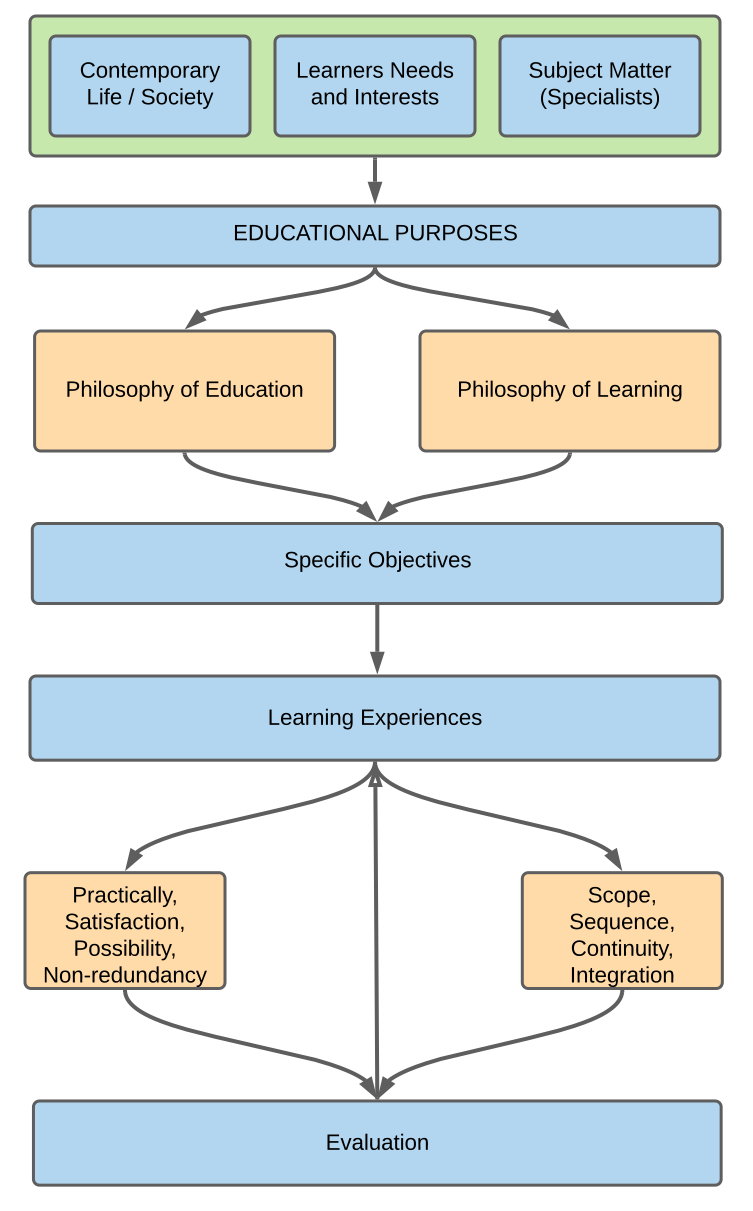
In applying Tyler’s model to curriculum design, the process begins with framing objectives for the curriculum. Because of its emphasis on the importance of objectives, it is considered an objective-based model. This process starts with analyzing information from various data sources. Data sources for curriculum according to Tyler include:
From these sources, the designer develops general objectives. These are subjected to a screening process, using the philosophy of education and psychology of learning as the major screens. Social values are also used as a screen, but sometimes these are subsumed in the philosophy of education. This yields a feasible number of objectives that are focused on in education.
Specific objectives are then derived from the general objectives. For each of the specific objectives, learning experiences are identified. In this context, the learning experiences include the subject matter/content and learning activities.
The next step is the organization of learning experiences. This is done to ensure effective learning takes place. The various principles of the organization include scope, sequence, integration, and continuity, among others. The final step involves evaluation, to determine the extent to which the objectives have been met.
Feedback from the evaluation is then used to modify the learning experiences and the entire curriculum as found necessary.
Learning experiences refer to the interaction between the learner and the external conditions in the environment which they encounter. Learning takes place through the active participation of the students; it is what the students are involved in that they learn, not what the teacher does.
The problem of selecting learning experiences is the problem of determining the kind of experiences likely to produce given educational objectives and also the problem of how to set up opportunity situations that evoke or provide within the student the kinds of learning experiences desired.
The term subject matter/content refers to the data, concepts, generalizations, and principles of school subjects such as mathematics, biology, or chemistry that are organized into bodies of knowledge sometimes called disciplines. For instance, Ryman (1973) specifically defines content as:
Knowledge such as facts, explanations, principles, definitions, skills, and processes such as reading, writing, calculating, dancing, and values such as the beliefs about matters concerned with good and bad, right and wrong, beautiful and ugly.
The selection of content and learning experiences is one crucial part of curriculum making. This is mainly because of the explosion of knowledge that made the simplicity of school subjects impossible. As specialized knowledge increases, it is necessary either to add more subjects or to assign new priorities in the current offerings to make room for new knowledge and new concepts.
New requirements for what constitute literacy have also emerged. In secondary schools, the usual method of accommodating new demands is to introduce new subjects or to put new units into existing subjects.
Improved educational technology such as the use of television, radio, computers, and multi-media resources support an expansion of what can be learned in a given period. New technological aids for self- teaching, for communicating information, and for learning a variety of skills are shifting the balance of time and effort needed for acquiring a substantial portion of the curriculum. What then are the criteria for the selection of content?
Several criteria need to be considered in selecting content. These include the validity, significance, needs, and interests of learners.
Validity
The term validity implies a close connection between content and the goals which it is intended to serve. In this sense, content is valid if it promotes the outcomes that it is intended to promote. In other words, does the curriculum include concepts and learnings that it states it does?
Significance
The significance of curriculum content refers to the sustainability of the material chosen to meet certain needs and ability levels of the learners.
Needs and Interests of the Learner
The needs and interests of the learners are considered in the selection of content to ensure a relevant curriculum to the student’s world. This also ensures that the students will be more motivated to engage with the curriculum.
Utility
In this context, the subject matter of a curriculum is selected in the light of its usefulness to the learner in solving his/her problems now and in the future.
Learnability
Curriculum content is learnable and adaptable to the students’ experiences. One factor in learnability is the adjustment of the curriculum content and the focus of learning experiences on the abilities of the learners. For effective learning, the abilities of students must be taken into account at every point of the selection and organization.
Consistency with Social Realities
If the curriculum is to be a useful prescription for learning, its content, and the outcomes it pursues need to be in tune with the social and cultural realities of the culture and the times.
The Goodlad model deviates a bit from the Ralph Tyler’s model. It is particularly unique in its use of social values. Whereas Tyler considers them as a screen, Goodlad proposes they are used as data sources. Hence, Goodlad proposes four data sources:
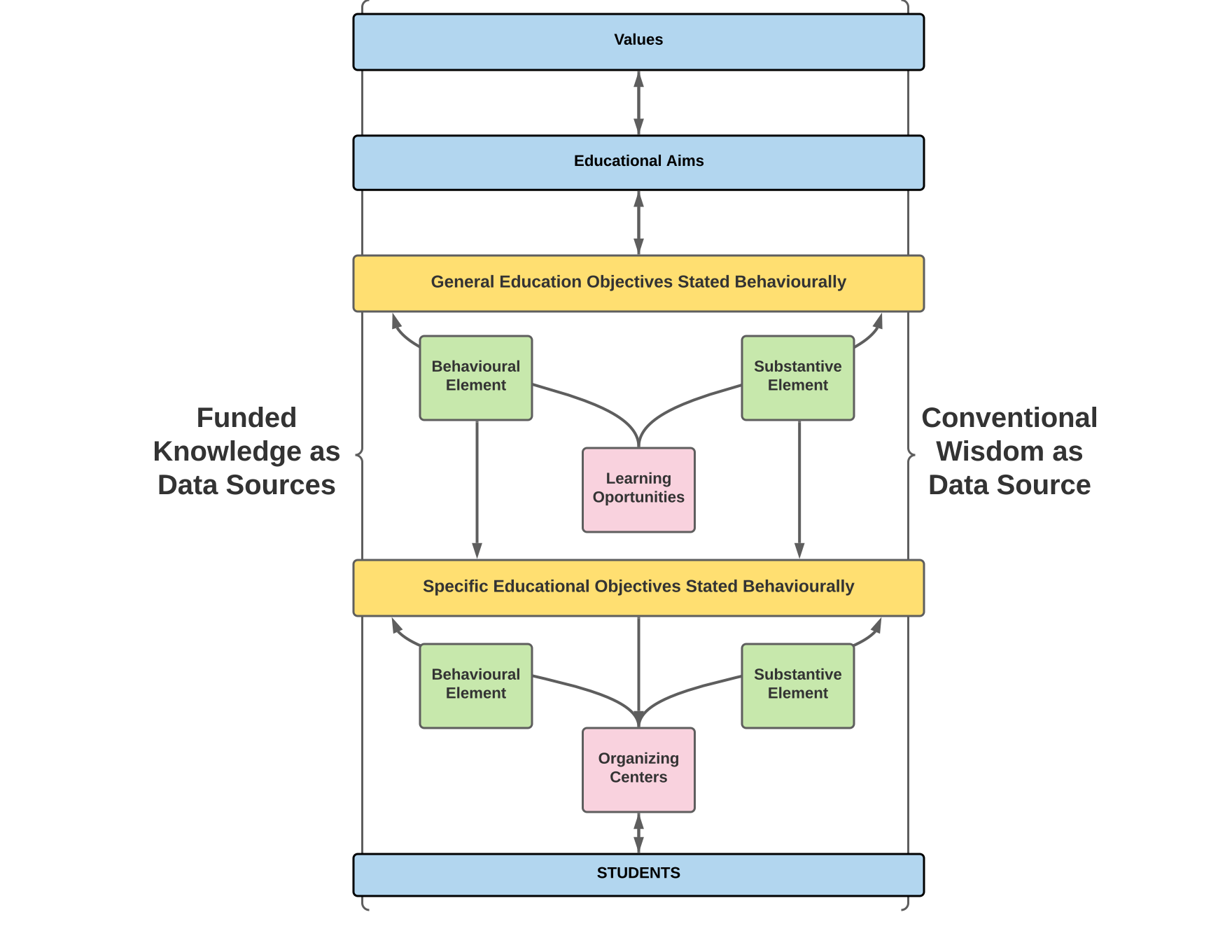
John Goodlad was a Canadian-born educator and author who believed that the most important focus of education should not be based on standardized testing, but rather to prepare young people to be well-informed citizens in democracy. His inclusion of values in the curriculum-development chart reflects his belief that educational systems must be driven by goals or values. He believed that education has a moral dimension, and those who teach are “moral agents.” To be a professional teacher means that one is a moral agent with a moral obligation, including initiating the young into a culture. In the United States, this means “critical enculturation into a political democracy” because a democratic society depends on the renewal and blending of self-interests and the public welfare (Goodlad, 1988). For that reason, Goodlad places “values” at the very top of his model.
Funded knowledge is knowledge which is gained from research. Generally, research is heavily funded by various organizations. Information from research is used to inform educational practice in all aspects, particularly in curriculum design.
Conventional wisdom includes specialized knowledge within the society, for example from experts in various walks of life and ‘older’ people with life experiences. Students’ needs and interests are also considered in the design process.
Data from the various sources are then used to develop general aims of education from which general educational objectives are derived. These objectives are stated in behavioral terms. A behavioral objective has two components: a behavioral element and a substantive element. The behavioral element refers to the ‘action’ that a learner is able to perform, while the substantive element represents the ‘content’ or “substance” of the behavior.
From the general objectives, the curriculum designer identifies learning opportunities that facilitate the achievement of the general objectives. This could, for example, be specific courses of study.
The next step involves deriving specific educational objectives stated behaviorally. These are akin to instructional objectives. They are used to identify “organizing centers” which are specific learning opportunities, for example, a specific topic, a field trip, an experiment, etc.
Regarding evaluation, Goodlad proposed continuous evaluation at all stages of the design process. In the model, evaluation is represented by the double-edged arrows that appear throughout the model.
Goodlad’s model departs from the traditional model based on Tyler’s work in several ways:
Curriculum literature still has many more models for design. We shall highlight a few of them.
There are many other curriculum design models developed by different scholars. Most of these models are objectives-based, i.e. they focus on objectives as the basis upon which the entire design process is based, and draw a lot from the work of Ralph Tyler. Those include the Wheeler, Kerr, and Taba models.
D.K. Wheeler developed a cyclic model in reaction to criticism leveled at Ralph Tyler’s model. The latter was seen as being too simplistic and vertical. By being vertical, it did not recognize the relationship between various curriculum elements. His cyclic proposal was therefore aimed at highlighting the interrelatedness of the various curriculum elements. It also emphasizes the need to use feedback from evaluation in redefining the goals and objectives of the curriculum.
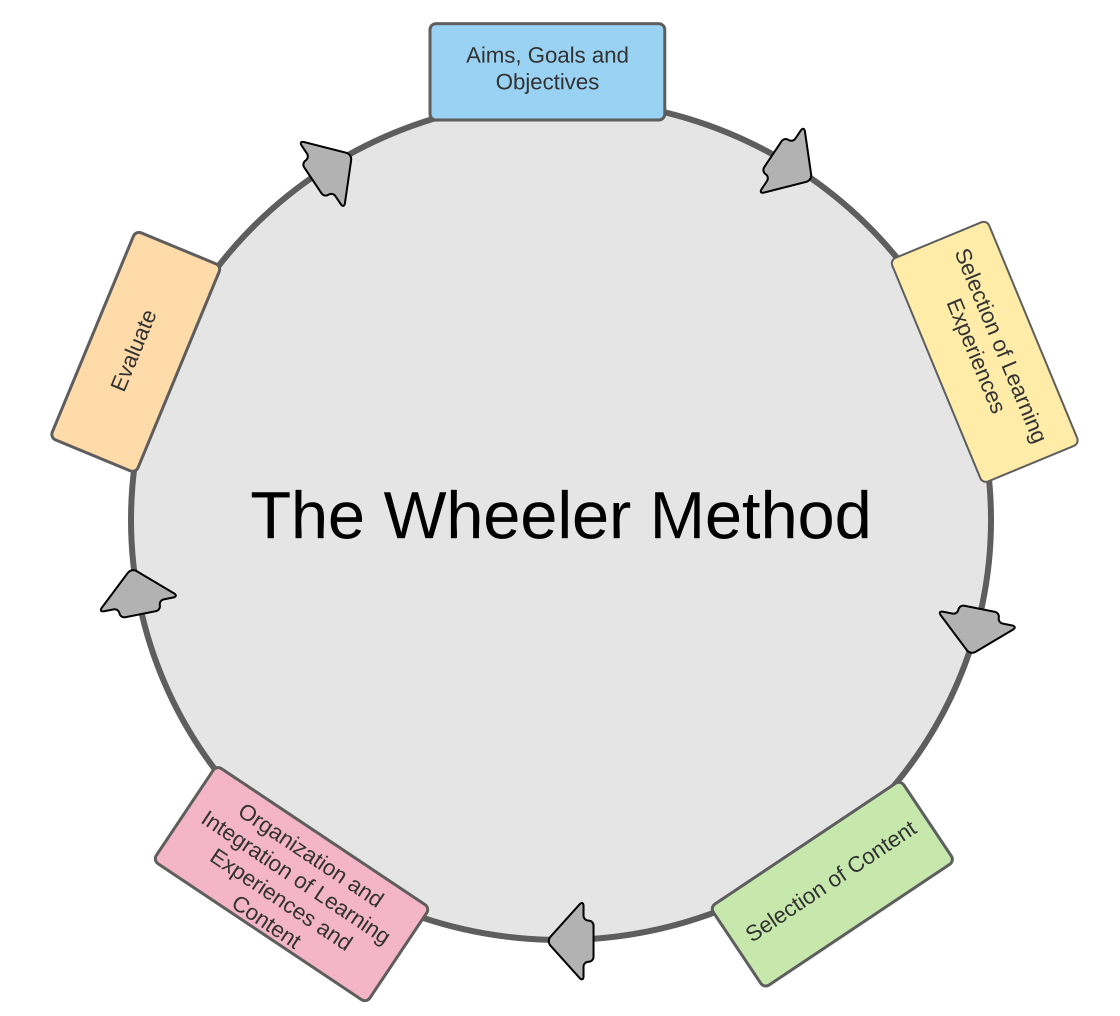
Other scholars who were also convinced of the ‘objectives’ approach to curriculum design were John Kerr and Hilda Taba. Their work is summarized in the simplified models presented in the graphic presentations that follow. Both of them emphasize the interrelatedness of the various curriculum elements.
John Kerr, a British Curriculum specialist in the 1960s, was particularly concerned with the following issues: objectives, knowledge, school learning experiences, and evaluation. This is reflected in the sketch below.
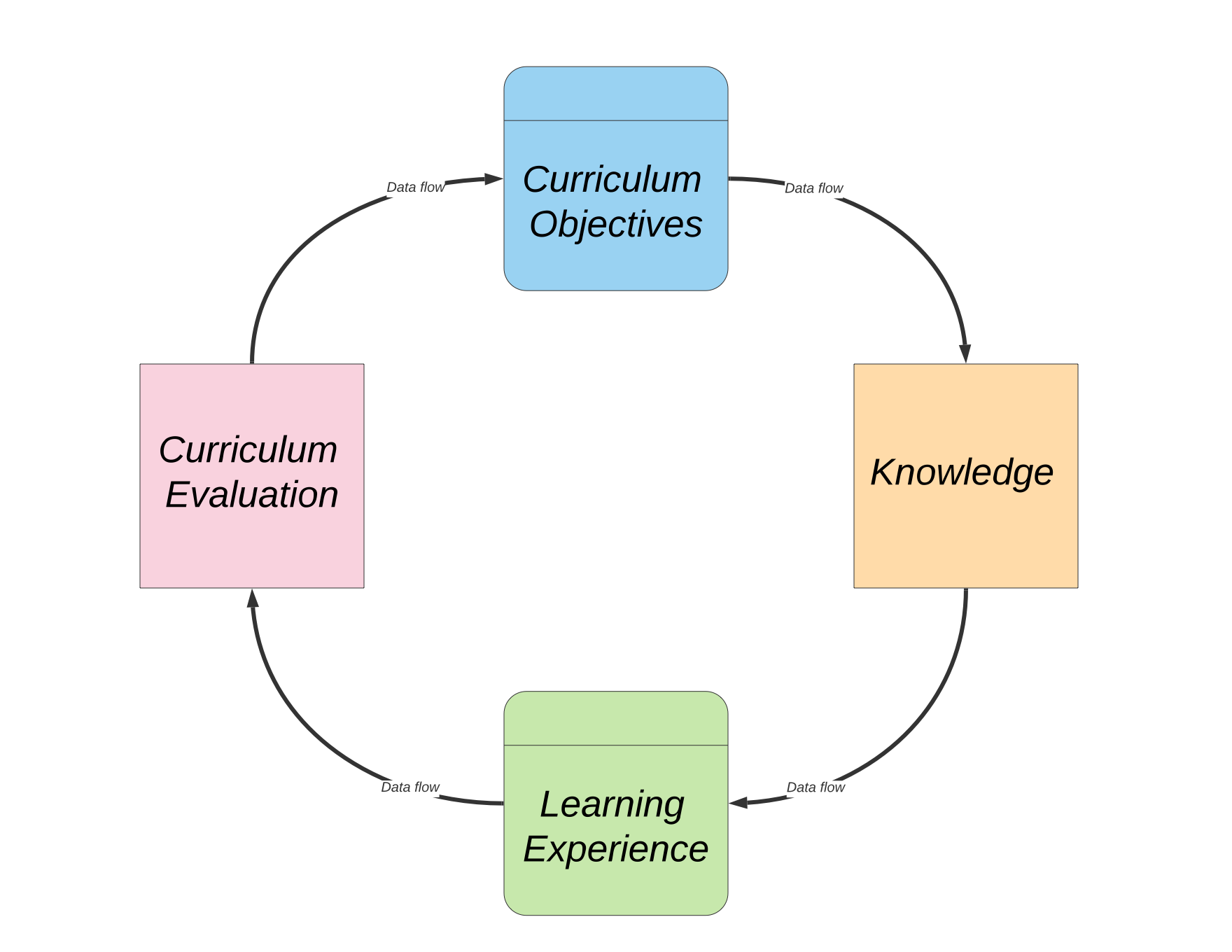
Kerr’s model is in many ways similar to that of Ralph Tyler and Wheeler. The difference is the emphasis on the interrelatedness of the various components in terms of the flow of the data between each component.
Hilda Taba was born in Europe and emigrated to the United States during a tumultuous time in history that had a great effect on her view of education. She was initially influenced by progressivists: John Dewey and Ralph Tyler, and one of her goals was to nurture the development of students and encourage them to actively participate in a democratic society. Taba’s model was inductive rather than deductive in nature, and it is characterized by being a continuous process.
Taba’s model emphasized concept development in elementary social studies curriculum and was used by teachers in her workshops. She was able to make connections between culture, politics, and social change as well as cognition, experience, and evaluation in curriculum development, particularly in the areas of teacher preparation and civic education. Taba’s work with teachers in communities around the United States and in Europe has provided a blueprint for curriculum development that continues to be used by curriculum developers today. To explore more information about Taba and her work, you may access Taba’s Bio.
Hilda Taba, on her part, was also influenced by Ralph Tyler. Her conceptual model follows. The interrelatedness of the curriculum elements from both models suggests the process is continuous.
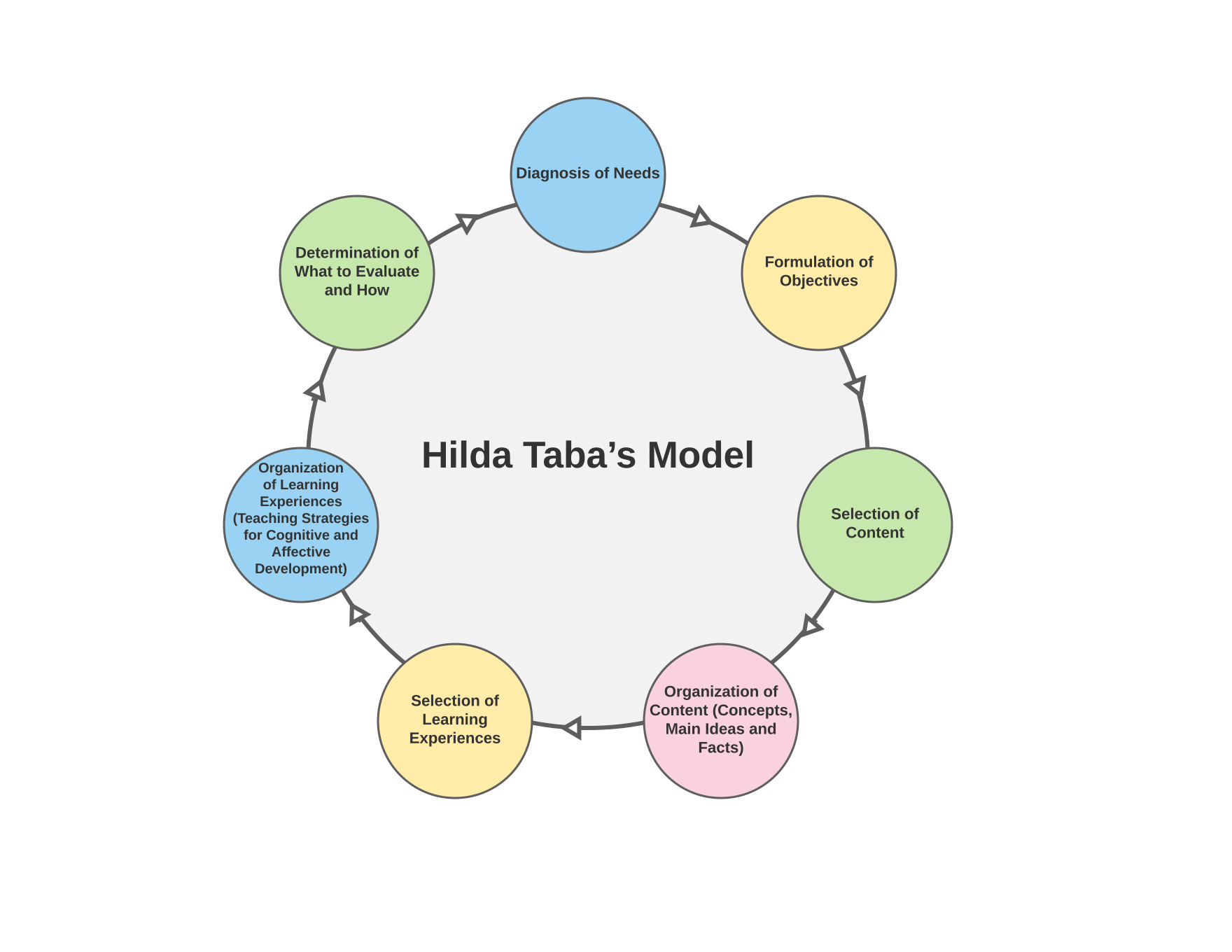
Several factors need to be taken into account when designing a curriculum. These include:
There is no “silver bullet” in designing curriculum. What is best for one classroom or one district may not work somewhere else. When setting up the process, using a combination of designs might work best.
If you were leading a curriculum committee, which model would you use for the curriculum development process?
Respond using the Hypothesis ILA Responses Group annotation tool. Choose the content area(s) and grade level(s), a specific model or a combination of models, and include rationale for your choices.
Curriculum design is central to the development of curriculum, and it can be done in several ways. Each design has advantages and disadvantages for both learners and teachers. Ralph Tyler included four questions that guided his curriculum design model. Tyler’s model influenced later curriculum designs by John Goodlad, D.K. Wheeler, John Kerr, Hilda Taba, and others. In the next chapter, we look at how curriculum is developed and its scope.
Curriculum Essentials: A Journey Copyright © 2021 by Linda J. Button, Ed.D. is licensed under a Creative Commons Attribution-ShareAlike 4.0 International License, except where otherwise noted.